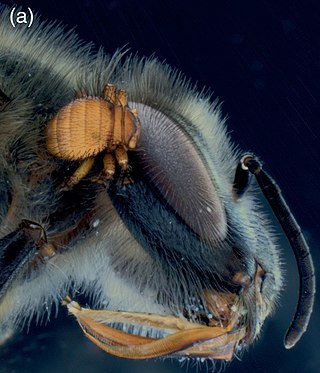
Braulidae, or bee lice, is a family of true flies (Diptera) with seven species in two genera, Braula and Megabraula. They are found in honey bee colonies due to their phoretic, inquiline, and kleptoparasitic relationships with the bees. Similar in appearance but not closely related to keds, these flies are also small, wingless, and occasionally mistaken for mites or lice, hence their common name.

The Therevidae are a family of flies of the superfamily Asiloidea commonly known as stiletto flies. The family contains about 1,600 described species worldwide, most diverse in arid and semiarid regions with sandy soils. The larvae are predators of insect larvae in soil.

The Heleomyzidae is a small family of true flies in the insect order Diptera. Over 740 described species of Heleomyzidae occur in about 76 general distributed throughout the world.

The Mydidae, or Mydas flies, are a cosmopolitan family of flies. It is a small family, with about 471 species described. They are generally large in size, including the largest known fly, Gauromydas heros. Many of the species, in addition to their large size, are mimics of stinging hymenopterans, especially wasps. Most mydids are found in arid and semiarid regions of the world, but they are also found in other habitats.
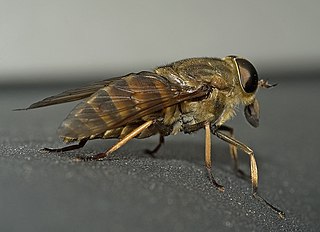
The Brachyceran infraorder Tabanomorpha is a small group that consists primarily of two large families, the Tabanidae and Rhagionidae, and an assortment of very small affiliated families, most of which have been included within the Rhagionidae.

The Brachyceran family Vermileonidae is a small family of uncertain affinities and unusual biology. It includes fewer than 80 described species, most of them rare and with restricted distribution, in 11 genera. Historically the vermileonids had been regarded as belonging to the family Rhagionidae, possibly in a subfamily Vermileoninae. Their biology and morphology are so markedly distinct from the main Rhagionidae sensu stricto however, that the placement as a separate family has been widely accepted.
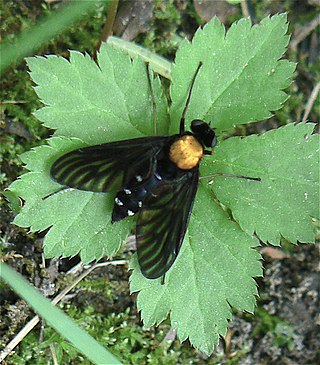
Chrysopilus is common, worldwide genus of predatory snipe flies. There are approximately 300 species in the genus, including fossil members that are sometimes found in amber.

Rhagionidae or snipe flies are a small family of flies. They get their name from the similarity of their often prominent proboscis that looks like the beak of a snipe.

Clusiidae or "druid flies" is a family of small, thin, yellow to black acalyptrate flies with a characteristic antenna and with the wing usually partially infuscated. They have a cylindrical body. The head is round, the vertical plate reaches the anterior margin of the frons and the vibrissae on the head are large. The costa is interrupted near subcosta and the latter developed throughout length. Larvae are found in the bark of trees, the flies on trunks. The larvae are notable for their ability to jump. Males of many species in the subfamily Clusiodinae have been observed while engaged in lekking behaviour. There are hundreds of species in 14 genera found in all the Ecoregions, although most species occur in tropical regions. The type genus is Clusia Haliday, 1838.
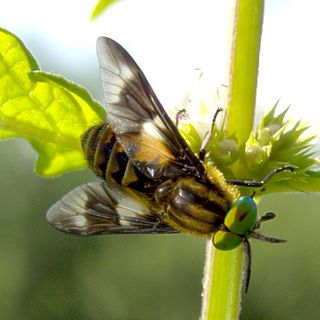
Superfamily Tabanoidea are insects in the order Diptera.

Athericidae is a small family of flies known as water snipe flies or ibis flies. They used to be placed in the family Rhagionidae, but were removed by Stuckenberg in 1973. They are now known to be more closely related to Tabanidae. Species of Athericidae are found worldwide.

The fly genus Deuterophlebia is the sole member of the small monogeneric family Deuterophlebiidae or mountain midges. Adults have broad, fan-shaped wings, and males have extremely long antennae which they employ when contesting territories over running water, waiting for females to hatch. Larvae occur in swiftly flowing streams and are easily recognized by their forked antennae and the prolegs on the abdomen.
Spaniopsis is a genus of snipe flies of the family Rhagionidae. They are very stout bodied flies from 3 to 6 mm, with generally grey or dark grey thorax, and are only known from Australia.
Austroleptis is a genus of snipe flies, and the sole genus in the family Austroleptidae; until 2010, it was placed in the family Rhagionidae. They are small to moderately sized flies of around 3 to 7.7 mm.
Arthroceras is a genus of snipe fly of the family Rhagionidae. Arthroceras are mid-sized to large 4.5 to 13 millimetres, black, grey, or yellowish-colored flies that have a fairly long, tapering antenna consisting of 5–8 flagellomeres. Within Rhagonidae, the genus is sometimes(?) placed in the subfamily Arthrocerinae, in which it is the only genus.
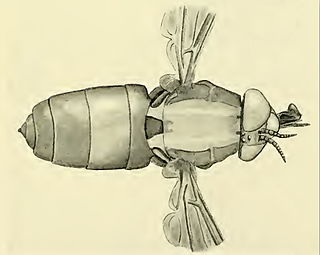
Pelecorhynchus is a genus of flies from the family Pelecorhynchidae. The adults mostly feed on nectar of Leptospermum flowers. Larvae have been collected in the damp margins of swamp areas, where they feed on earthworms.

Rhagioninae is a worldwide subfamily of predatory snipe flies.

Sympycninae is a subfamily of flies in the family Dolichopodidae. In some classifications, this subfamily includes the genera of the subfamilies Peloropeodinae and Xanthochlorinae.

Dialysis is a genus of flies in the family Xylophagidae.

Chrysopsinae is an insect subfamily in the family Tabanidae commonly known as deer flies or sheep flies and are bloodsucking insects considered pests to humans and cattle. They are large flies with large brightly-coloured compound eyes, and large clear wings with dark bands. They are larger than the common housefly and smaller than the horse-fly.


















